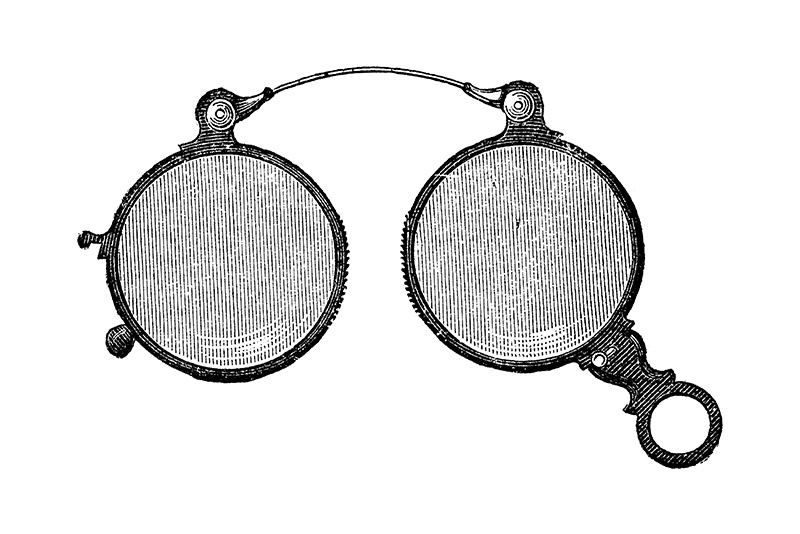
Written By: NATALIE JACEWICZ

Nearsightedness, or myopia, is increasing at an eye-popping rate. By 2050, scientists predict more than 4.7 billion people, roughly half of the global population, will be nearsighted.
Fortunately, humans have created a solution — eyeglasses! People can rest assured they will always be able to read the dumb bumper stickers on the cars in front of them. But how did people manage thousands of years ago?
Shots called ophthalmologists and corrective eyewear historians (yes, they exist) to find answers.
First, the prevalence of human eyesight issues has changed over time. “As long as primates have been around, there’s probably been myopia,” says Dr. Ivan Schwab, a professor of ophthalmology at the University of California, Davis and author of Evolution’s Witness: How Eyes Evolved. But he says the rates of myopia have skyrocketed over the past three centuries.
The reason likely has to do with a rise in reading, Schwab says. Though genes and nutrition may play a role in nearsightedness, he says education and myopia seem to be linked, suggesting that when people do a lot of close work, their eyes grow longer — the better to focus up close, but the worse for long-distance vision. Some ophthalmologists believe that dim light exacerbates this effect, Schwab says.
Scientists are still working out the exact mix of factors that contribute to myopia, but, on average, humans thousands of years ago probably had to squint less to see at a distance, according to Schwab. What happened to the few who were shortsighted?
“You can imagine that if people with nearsightedness had some special skill, they might even be revered,” says Schwab. Fine engravings found on ancient coins, for example, might have benefited from a nearsighted artist’s craftsmanship. “Now that’s just speculation,” he adds. “I can’t prove that.” Another possible upside of myopia? It could mitigate the difficulty of seeing up close that comes with aging.
Things started to look up for the visually challenged at the end of the 13th century, when the earliest known eyeglasses were invented in northern Italy. The region was a hub for glass production, says Neil Handley, the museum curator at the College of Optometrists, London. Merchants soon carried spectacles along the Silk Road to Asia, where they served as status symbols. Some judiciary committees in China even mandated spectacles as part of the uniform. Still, they didn’t become as common there as they did in Europe, where spectacles were produced.
These glasses had more in common with magnifying glasses than today’s eye accessories. “You pick them up, and you feel the difference,” says Jenny Benjamin, director of the American Academy of Ophthalmology’s Museum of Vision. “You can’t wear them on your face; they’d just fall off.”
Early glasses were heavy and prone to shattering, Benjamin says. They were intended to help people read, rather than aid nearsightedness. Often, glasses featured quartz instead of glass, since the latter was often turbid.
Glasses for nearsightedness likely arose in the 15th century. “Because they were seen as being unusual and rare, they were seen as having magical powers,” says Handley. People who wore glasses “were in league with the devil, immoral.”
But after the Reformation, when literacy rates climbed, spectacles became more common. In the 1700s, temple pieces — the long extensions of glasses that fit snugly against the head — allowed people to wear glasses throughout the day. Styles diversified rapidly, featuring different colors and expensive materials.
“They’re still universally seen as a disability aid. And they’re slightly embarrassing,” Handley says of glasses in the 18th century. “But nonetheless, if you’re at the richer end of the market, you can show off a bit.”
Before prescriptions, customers tried on glasses and chose a pair through trial and error, often from a traveling peddler. But in the 1800s, Handley says, people began receiving eye exams for glasses. In 1862, Dutch ophthalmologist Herman Snellen invented the standardized eye chart that taunts so many today.
Of course, glasses still present challenges. Xavier Holland of Boston, 28, has worn glasses for nearsightedness since he was 10. The glasses fog when Holland opens the dishwasher and make 3-D glasses at the movies a pain.
But Holland appreciates another benefit ancient humans didn’t get to enjoy: fashion. “It’s an easy way to seem interesting or different,” he says. “If you’re looking for a way to jazz up your look, you can always just get some new frames.”
© 2024 Siegmund Eye Care • Web Design by Three Ring Focus • Privacy / Terms / Employment